What will confirmed omicron case mean for California’s COVID response? What we know

Local, state and federal health officials on Wednesday confirmed the first U.S. case of the omicron variant of COVID-19, in San Francisco.
It remains unclear what effects the discovery might have on the pandemic’s trajectory and mitigation measures in California, where virus infections and hospitalizations — from the still-dominant delta variant — remained largely on a plateau for most of November.
The California Department of Public Health and San Francisco Department of Public Health in a joint statement confirmed the case discovery, and credited the state’s “robust” genome sequencing surveillance program, as well as partners at UC San Francisco laboratories, for identifying it.
Omicron, designated a variant of concern last week by the World Health Organization, was first detected by health officials in South Africa, though later lab sequencing determined there were earlier cases in the Netherlands.
Health experts worldwide say it will likely take a few weeks — roughly the middle or end of December — for researchers to determine whether omicron is more transmissible, more severe or can undermine protection from vaccines or prior infection.
Still, some health experts and vaccine manufacturers say existing vaccines and their boosters are likely to provide at least some protection, as they have for other strains.
“There’s no reason to panic — but we should remain vigilant,” California Gov. Gavin Newsom tweeted Wednesday morning. “That means get vaccinated. Get boosted. Wear a mask indoors.”
Will there be new restrictions?
It remains to be seen what other measures, if any, California and local jurisdictions may take in response to omicron.
San Francisco Director of Public Health Dr. Grant Colfax during a news conference Wednesday said the city does not expect to change or impose any new COVID-19 restrictions at this time.
Health agencies and government leaders continue to urge residents to get vaccinated and boosted.
“The panic’s gotten ahead of the information,” Newsom added, regarding omicron, during a Wednesday news conference at a Merced County vaccine clinic.
Last week, in response to growing concerns about the omicron variant, multiple countries including the U.S. imposed travel bans on southern African countries. The Biden administration’s ban blocked non-U.S. citizens from entry, and said American citizens must present a negative COVID-19 test before entering.
In its joint statement with the San Francisco health office, CDPH said California “is increasing COVID-19 testing at our airports for arrivals from countries identified by the Centers for Disease Control and Prevention (CDC).”
More details on first U.S. omicron case
The case sequenced in San Francisco was confirmed for omicron on Nov. 29, one week after the infected person returned from travel in South Africa, White House adviser and infectious disease expert Dr. Anthony Fauci told reporters at the White House, according to the Associated Press and other news outlets.
Fauci said the person was fully vaccinated and was experiencing “mild symptoms.”
Colfax said the infected person had received two doses of Moderna’s vaccine and confirmed they had not received a booster.
Newsom during his Wednesday news conference said the infected person is a San Francisco resident.
How did state, counties respond to the last variant of concern?
California on June 15, shortly before delta emerged as dominant in the state, dropped most coronavirus restrictions, including the mask mandate for the fully vaccinated. CDPH currently recommends, but does not require, masking in indoor public spaces.
Several counties, including Sacramento and most of the Bay Area, returned to indoor mask mandates in direct response to the delta variant, which led to a summer surge of cases that peaked in those areas around mid-August.
Some, including Sacramento and Yolo counties, have kept their mask requirements for indoor public places.
Others, including Marin and Stanislaus counties, removed them last month as local case rates declined.
Neither the state nor any county health offices returned to stricter measures that dominated the first year-plus of the pandemic: capacity restrictions, social distancing requirements or business closures.
Officials say to keep ‘guard up’ around winter holidays
Already, before omicron was discovered globally, health officials had been warning of a possible winter surge due to colder weather, major holidays and increased travel, urging residents to get vaccinated and take other precautions.
Newsom said Wednesday that California’s COVID-19 numbers “are not as acute” as this time last year, but noted that the state continues to wait to see the impact not just of omicron, but of the recent Thanksgiving holiday.
CDPH data show about 3,200 patients are hospitalized with confirmed COVID-19, including about 850 in intensive care units. That’s up from about 1,000 hospitalized and 250 in ICUs in late June, before delta arrived, but far below the 8,500 hospitalized and 2,000 in intensive care at the start of December 2020.
The state’s test positivity has spiked in the past week from 1.9% to 3.4%, though processing delays related to the Thanksgiving holiday may be skewing that number.
If there is a definitive post-Thanksgiving surge, it likely would not show up in the data until about two weeks later, in mid-December.
“I know we’re tired. I know people are looking forward to the holidays,” state Health and Human Services Secretary Dr. Mark Ghaly said in Wednesday’s news conference, speaking after Newsom. “But I think some simple tools that allow us to live and do the things that we’re excited about in these many couple weeks can still happen, with our guard up.”

 Yahoo Movies
Yahoo Movies 
